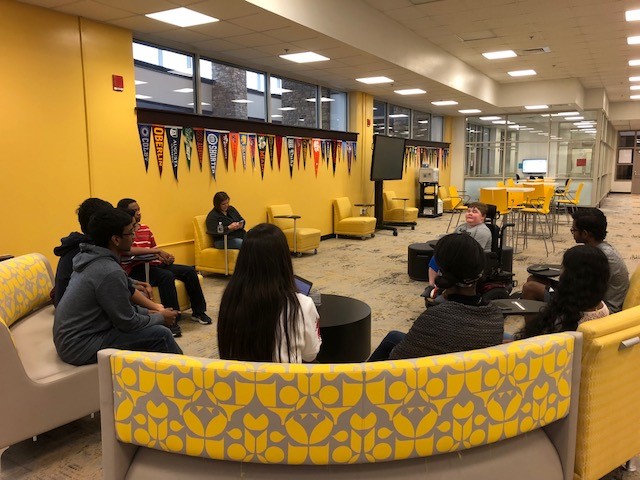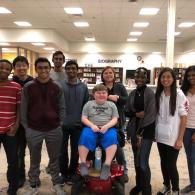Team Synergy is here!
Team Synergy is making a device for wheelchairs to be able to go across different terrains. An off-road wheelchair would be an appropriate name for the invention. With nine bright and creative minds, we are collaborating with each other to make this the best possible journey in making a device that could help many.
December was a busy month for the CHS Synergy build team. We began the month by addressing the critiques of Travis King (Georgia Tech Invention Studio President) of our old design. His main comments had to do with the size, the feasibility, and structural integrity of the chassis. Going through his criticisms, we began to doubt our original design and began to make slight modifications to the design. Soon we ended up with a completely new design. This simplified the design by reducing the number of moving parts, simplifying the mounting mechanism for the wheelchair, and theoretically gave the user more control over the wheelchair’s movements. But along with the new simpler design, we already struck some issues with addressing our goals of easy transportation and safety. With the new design, the build team began to familiarize themselves with the FRC(First Robotics Competition) electronic control systems. One our members, Sahil Sudi, has prior experience in the field and explained the basic workings of the system. But after Sahil stopped participating in FRC, there have been some small changes to the type of components used, which we worked on as a team. Currently, we are in the process of ordering the crucial electronics for the wheelchair, working on a final design in CAD, and planning another visit to Georgia Tech to receive more suggestions.
As of now, the CHS Synergy communication team is trying to reach out to reporters in the area since we haven’t had much luck with other reporters. We already have a plan to reach out to our school’s Speculator team so that we can have our invention shared with the rest of the school as well as the date of the Mid-Grant Technical Review, which will allow our fellow peers to join us if interested. We have also contacted several potential sponsors that could help us raise money for the Mid-Grant Technical Review and tickets to EurekaFest. As of now, we are mainly having problems with getting other companies and people to sponsor us, but we are trying our best to reach out to as many people as possible. To do this, we are making a promo video that will be uploaded to YouTube, which will show the audience who we are, what we are inventing, and what each team is in charge of. Our social media sites will be shared at the end of the video as well as our GoFundMe page, which we have created recently. Team Synergy already has Instagram, Twitter, and Facebook pages, where we are continuing to post more updates and following more people in our community. Once we are done with our promo video we will upload it to all our social media sites for ease of access. We continue to update our Wixsite, which has already been shared through our Facebook page. We have also reached out to our school’s Rotary Club, and we plan to have a meeting once we get back to school to continue to work together to fundraise for the team. Our team has recently had an interview with Kyle, a middle schooler who has arthritis, and the build team has gained more information on how to improve design. The communication team has already contacted Kyle’s mother to get the contact information of people who could sponsor our invention as well as be interested in coming to our Mid-Grant Technical Review. We will also add them to the invitation list that we are making for the MGTR on February 22nd.
Mithuna Kanthasamy, the sustainability lead, has been working on the SolidWorks Sustainability Course. She has learned that one way of making a sustainable device is by making it possible for the device to be disassembled so that the materials can be reused. She has collaborated with the build team and they have decided to create a disassemblable device.


As a whole, Team Synergy has been working really hard to meet expectations. We have had several meetings in order to gather ideas on how to improve the invention's design. Our main problem was that we were trying to make an invention that satisfied everything, including size, weight, and other criteria. However, now we are focusing only on one main issue at a time. This will help us organize our thoughts and continue with our design. As already stated, the team has already met up with Travis King, Georgia Tech Invention Studio President, to make necessary modifications to our invention's design. We have also had an interview with Kyle in order to know how we can make our invention better. We found out that the size is one important issue so that the wheelchair is able to go through doors. Another important issue that was mentioned during the interview was the ability for the device to allow the wheelchair to go on top of curbs. With the advice from both Travis and Kyle, Team Synergy hopes to improve the design as much as they can to move forward with the invention.


